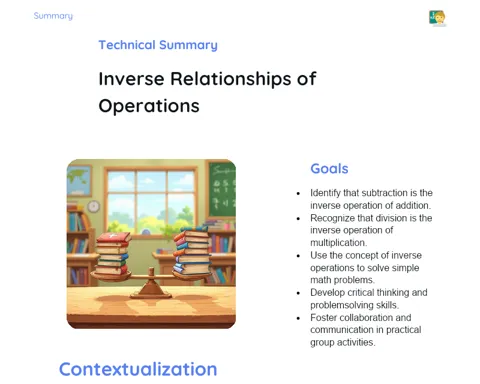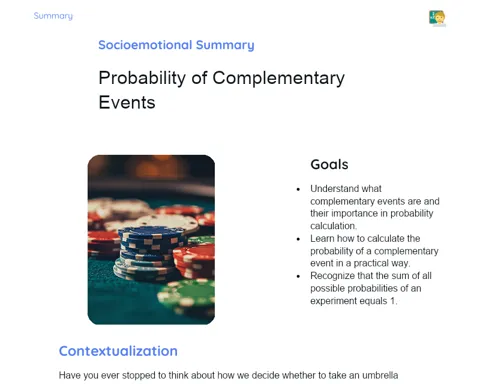Exploring the World of Probability
Objectives
1. Recognize the most likely and unlikely outcomes in various events (such as rolling dice, flipping coins, drawing cards from a deck).
2. Develop critical analysis skills to determine probabilities in practical everyday situations.
Contextualization
Probability is present in our daily lives, from weather forecasting to the chances of winning a game. Understanding what is likely or unlikely helps us make more informed and conscious decisions. For example, when choosing to take an umbrella, we consider the probability of rain. This shows how mathematics can be practical and relevant in our everyday lives.
Relevance of the Theme
In the job market, probability is essential in various fields. Statisticians use probability concepts to analyze data and make predictions. In the insurance sector, companies calculate the risk of events occurring to determine insurance prices. Even in gambling and sports, probabilities help understand the chances of winning or losing.
Introduction to the Concept of Probability
Probability is a measure that helps us determine the chance of a specific event occurring. It is expressed as a number between 0 (impossible event) and 1 (certain event). In practice, we use probability to make decisions based on uncertainties.
-
Probability helps us deal with uncertainties in everyday life.
-
It can be applied in various contexts, such as weather forecasts and games.
-
It is an essential tool in various professions, such as statistics and insurance.
Likely and Unlikely Events
Likely events are those that have a high chance of occurring, while unlikely events have a low chance of occurring. When rolling a die, for example, the probability of getting any number between 1 and 6 is equal, but the perception of probability can vary in different situations.
-
A likely event has a high chance of happening.
-
An unlikely event has a low chance of happening.
-
Understanding the difference helps in making informed decisions.
Practical Applications of Probability
Probability is used in many areas of daily and professional life. In games, it can determine winning strategies. In the job market, it is used for data analysis, economic forecasts, and risk management.
-
Helps predict outcomes in games and sports.
-
Used to calculate risks and make decisions in the insurance sector.
-
Essential for data analysis and economic forecasting.
Practical Applications
- In weather forecasting, meteorologists use historical data and mathematical models to calculate the probability of rain.
- In gambling, such as roulette and poker, probabilities help players make strategic decisions.
- In the insurance sector, analysts calculate the probability of events such as accidents and illnesses to determine policy premiums.
Key Terms
-
Probability: Measure of the chance of an event occurring, ranging from 0 to 1.
-
Likely Event: Event with a high chance of occurring.
-
Unlikely Event: Event with a low chance of occurring.
-
Experiment: A procedure that generates one or more possible outcomes, used to study probability.
Questions
-
How can understanding probability help you make more informed decisions in everyday life?
-
Think of a situation where you used (or could have used) probability to decide something important. How was that experience?
-
Why do you think probability is a valued skill in the job market? Give specific examples of professions that use it.
Conclusion
To Reflect
Probability is a powerful tool that helps us understand and predict events in our daily life. It not only assists us in making more informed decisions, but is also essential in various professions, such as statistics, insurance, and economics. By learning about likely and unlikely events, we develop a critical and analytical perspective that is valued both in personal life and in the job market. This lesson has shown us how mathematics can be applied practically and relevantly, enriching our ability to solve problems and make conscious decisions.
Mini Challenge - Practical Probability Challenge
Let's consolidate our learning about probability with a small practical challenge.
- Take a die and a coin.
- Flip the coin 10 times and note how many times it lands heads and how many times it lands tails.
- Roll the die 15 times and note the frequency of each number (1 to 6).
- Based on the results, discuss with a colleague which events were more likely and which were less likely.
- Write a brief reflection on how probability influenced the outcomes of your experiments.



